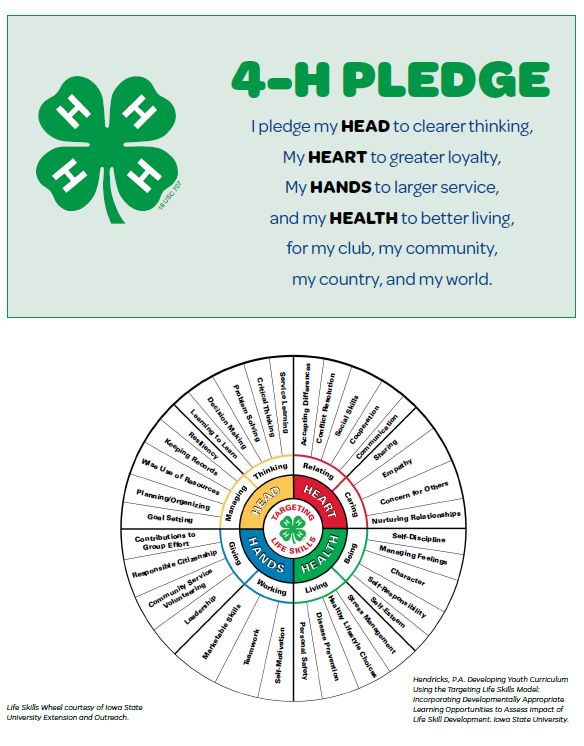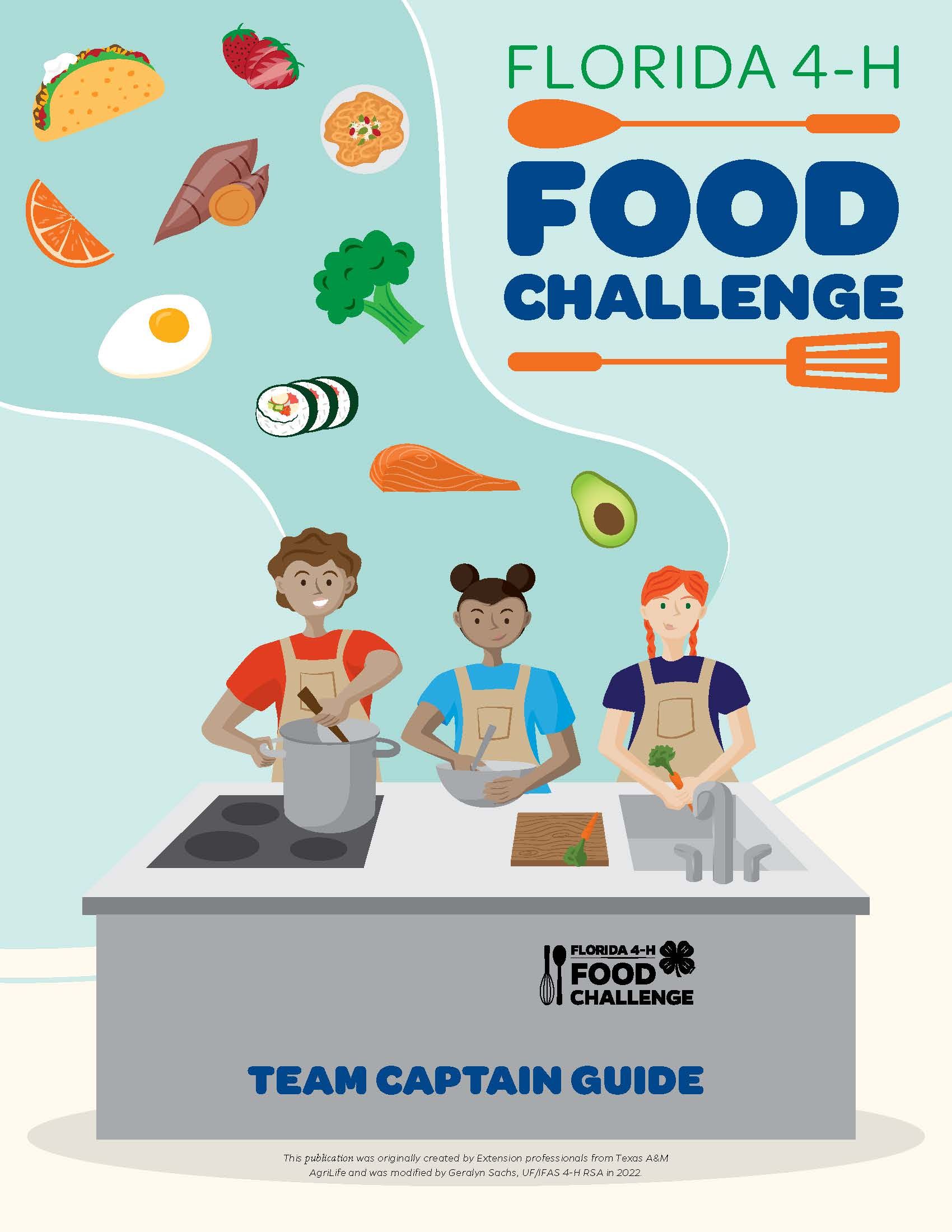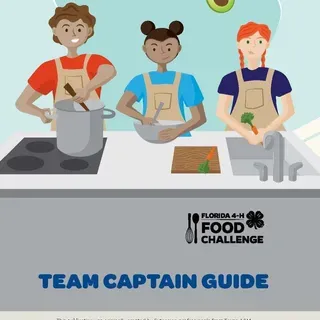Florida 4-H Food Challenge: Team Captain Guide
Why, the Florida 4-H Food Challenge?
More than 6,500 youth statewide participate in Florida 4-H food preparation and nutrition related 4-H projects each year. Through such project work, youth develop a wide variety of life skills that include, but are not limited to, healthy lifestyle choices, wise use of resources, problem solving, and planning/organizing. Research shows that the children who have cooking experience have healthier dietary habits and that their attitudes toward cooking predicted diet quality (Prescott, 2019). Preparing for and participating in the 4-H Food Challenge provides a positive and hands-on educational experience that prepares youth for the Food Challenge contest as well as their future.
The 4-H Food Challenge is a contest that provides a fun, yet challenging, food-focused learning opportunity for youth ages 8 to 18, (as of September 1st of the current 4-H year). Youth work together in teams of three to four, of the same age division, using a predetermined mystery ingredient, dish category, and standard set of cooking equipment. First, each team plans and prepares an assigned dish while being judged on their food safety skills, teamwork, and ability to manage time and resources. Then youth present their finished dish, deliver a 5-minute presentation, and answer questions about their dish to a panel of judges.
The Florida 4-H Food Challenge Objectives
- Provide an opportunity for youth to exhibit their knowledge of food safety and nutrition.
- Provide a comprehensive “project focused” team learning experience for youth related to food preparation, safety, nutrition, and cost analysis.
- Provide youth an opportunity to creatively compose and present an accurate educational oral presentation.
- Provide an opportunity for youth to develop critical thinking, problem solving, and marketable skills through food related project work.
How Can Youth Get Involved and Prepare for the 4-H Food Challenge?
Youth taking part in the 4-H Food Challenge must prepare for the Food Challenge contest by gathering three to four peers as teammates and at least two caring adults as Team Captains. Team Captains will work with youth through a series of hands-on educational sessions related to food and equipment safety, food preparation, nutrition, budgeting, serving size, visual appeal, oral presentations, teamwork, and more!
In addition to planning/leading educational sessions, Team Captains will be responsible for:
- Verifying youth ages for team competitions.
- Registering youth teams for competitions.
- Managing risks during educational sessions and mock contests.
- Incorporating positive youth development practices such as creating a sense of belonging, praise effort, and provide experiences that promote positive challenges for growth.
- Incorporating help from parents when appropriate.
- Encouraging teamwork and a spirit of fun.
The Florida 4-H Food Challenge Objectives
Note: The rules in this guide are for the Florida 4-H Food Challenge competition. Please refer to county and district guidelines for information on those contests, as there may be modifications.
Participation: Participants must be 4-H members currently enrolled in the Florida 4-H Youth Development Program (https://v2.4honline.com) actively participating in a food related project lead by two adult Team Captains. 4-H members are not eligible to compete at the Florida 4-H Food Challenge if they were previously part of a team that placed first at the National Food Challenge (State Fair of Texas).
Age: Age divisions are determined by the participant’s age as of September 1st of the current 4-H year.
Members per Team: Each team will have at least three and a maximum of four members. Teams may not include members in different age divisions.
Substitution of Team Members: Up to two substitutes can be identified on the entry form as alternate team members.
Registration and Entry Fee: Each team will be required to pre-register and pay all registration fees by the deadline.
Food Categories: There are four food categories in each age division: Appetizer, Main Dish, Side Dish, and Healthy Dessert. Teams will be randomly assigned to a category, which will not be announced until the contest.
Preparation: Each team will create an entire dish/recipe (not a full meal) using the provided mystery ingredient and grocery store items. Dishes/recipes created should include two or more servings. Teams should present the entire dish/recipe to the judges and communicate during their presentation what an individual serving size should be. Teams will be responsible for determining the number of servings their dish provides. Teams should not create side or multiple dishes with their ingredients/grocery store items.
Attire: Each team will have the option of wearing coordinated clothing or aprons. Each team member is required to wear closed-toe shoes and a hair restraint.
Resource Materials Provided at Contest: Resource materials will be provided for each team at the contest. These include MyPlate Mini-Poster, FightBac - Fight Food Borne Bacteria Brochure, Know Your Nutrients, and Food Safety Fact Sheet. Optional resources will include the Food Challenge Worksheet and copies of grocery receipts/purchase prices for calculating costs. No other resource materials will be allowed. Teams may not use their personal copies of the resources during the contest.
Supply Box: Each team must supply their own equipment for the challenge. Teams may bring only the supplies listed in the supply box section. Supply boxes may be checked by contest officials as teams check in for the contest using a standard or randomized process. Any extra equipment will be removed from the team’s supply box.
Each team will bring an equipment box containing only one each of the following items unless a different quantity is noted below:
- Beverage glass
- Bowls (up to 4 of any size)
- Calculator
- Can Opener
- Colander
- Cutting Boards (up to4)
- Disposable tasting spoons (no limit)
- Dry measuring cups (1 set)
- Electric Skillet
- Extension cord (multiple outlet or strip style)
- Teams should be certain the extension cord is compatible(2-prong/3-prong) with the plugs on their electrical supplies.
- First aid kit
- Food thermometer
- Fork
- Gloves
- Grater
- Hand sanitizer
- Hot pads (up to 5)
- Kitchen shears (1 pair)
- Kitchen timer
- Knives (up to 6)
- Liquid measuring cup
- Manual pencil sharpener
- Measuring spoons (1set)
- Non-stick cooking spray
- Note cards (1 package-no larger than 5 X 7)
- Paper towels (1 roll)
- Pancake turner (up to 2)
- Pencils (no limit)
- Plastic box & trash bags for dirty equipment
- Pot with lid
- Potato masher
- Potato peeler
- Sanitizing wipes (1container)
- Serving dishes/utensils 1 plate/platter
- 1 bowl
- 1 utensil
- Skewers (1 set)
- Skillet with lid
- Spatulas (up to 2)
- Stirring spoon
- Storage bags (1 box)
- Tongs (up to 2)
- Toothpicks (no limit)
- Two single-burner hotplates or
- One double- burner plate (electric only!)
- Whisk
Pantry Ingredients: Each team may include in their equipment box the following “pantry” ingredients which they may use when preparing their dish if desired. There is no requirement to use these items, nor is it mandatory that teams include these in their supply box.
- Salt
- Pepper
- Oils (up to 17 oz)
- 1 jar bouillon
- 1 medium onion
- 2 cans vegetables and/or fruit (up to 16 oz) - team choice
- Rice (white or brown) or pasta (up to 16 oz) - team choice
Participants with Special Abilities: Any competitor who requires auxiliary aids or special accommodations must contact the contest coordinator at least 2 weeks before the competition.
Awards: First place teams for each food category, per age division, will be recognized with a team ribbon.
Typical “Order of Go” on the Day of the 4-H Food Challenge
- Supply Box Check-In
- Contest Orientation
- Food Preparation/Presentation Planning-40 minutes
- Team Presentations
- Awards for all Age Divisions
Florida 4-H Food Challenge Rules for the Day
- General guidelines, resources, and instructions will be provided prior to the start of the contest to assist teams.
- No electronic devices or jewelry (except for medically required) are allowed in contest. This includes cell phones, smart watches, or other communication devices.
- Each team will be directed to a cooking/preparation station. Contest categories will be revealed at the preparation station.
- Each team will receive an information sheet with their contest category and mystery ingredient for that category (no ingredient amounts, recipe, or instructions will be provided at the station). The mystery ingredient will be representative of one of the following categories: Appetizer, Main Dish, Side Dish, or Healthy Dessert
- Teams will have access to a “grocery store” of additional ingredients which can be “purchased” and combined with the team’s mystery ingredient to create an original recipe/dish during the contest. The “grocery store” will include items commonly found in grocery stores such as produce, canned goods, crackers, dairy products, etc. Teams must “purchase” and use at least two additional items from the “grocery store”.
- Teams will receive a pricing sheet for “grocery store” items at their station. “Grocery store” items will be “purchased” using a pricing system and “contest currency.” This will enable teams to analyze the cost of their entire dish and individual serving. The currency system will be explained prior to the contest. Teams may not exceed the provided “contest currency” or trade “currency” or grocery store items with other teams. Teams will be provided a set dollar amount to “spend” at the store; each item in the store will be priced and teams must calculate cost according to total spent.
5. Each team will have 40 minutes to prepare the dish, plan a presentation, and clean up the preparation area.
6. Preparation: Each team will create an entire dish/recipe (not a full meal) using the provided mystery ingredient and grocery store items.
- Dishes/recipes created should include two or more servings. Teams should present the entire dish/recipe to the judges and communicate during their presentation what an individual serving size should be. Teams will be responsible for determining the number of servings their dish provides. Teams should not create side or multiple dishes with their ingredients/grocery store items.
- Teams are challenged to be creative and develop an original recipe with the ingredients provided.
- Teams will determine the exact amount of each ingredient used based on their original recipe.
- The mystery ingredient and/or grocery store ingredients selected should be used to garnish the dish.
- Note cards may be used to write down the recipe that the team creates, along with notes related to nutrition, food safety, and cost analysis. Teams should be exact on ingredients used, preparation steps, cooking time, temperature, etc.
7. Food and Equipment Safety: A safe and sanitary working environment must be maintained during the contest. Each station will have food and kitchen safety resources. Teams should follow the steps listed to ensure proper food and equipment safety is followed. Judges will be scoring teams on food and equipment safety during the preparation phase of the contest. Teams should also discuss safety steps used during the presentation phase of the contest.
- Gloves: Gloves do not have to be worn throughout the contest; however, there should always be a barrier between your hand and any food touched. A barrier includes gloves and/or cooking utensils. When wearing gloves, they must be changed between handling raw meats/seafood, handling cooked items, and ready to eat items or raw vegetables to prevent cross contamination.
- Hair Restraint: Each team member must wear a hat, hair net and/or other type of hair restraint during the food preparation part of the competition. Examples of acceptable hair restraints include hairnets, bandanas with hair completely pulled back, Chef hats with hair restrained inside, or caps with hair completely tucked inside.
- Illness: Team members who are not feeling well and/or are showing signs of illness will not be able to take part in the food challenge. This is an opportunity for an alternate team member to step in.
8. Nutrition: Each station will have a variety of nutrition resources/references. Each team should highlight key nutrients in their dish and their functions during their presentation.
9. Cost Analysis: Price(s) of the mystery ingredient and grocery store items will be provided to teams. Teams will calculate the price of the dish based on the amount of ingredients used. Teams should calculate the cost of the total recipe, as well as the price per serving. Teams will determine the number of servings for their recipe.
10. Presentation: Following the preparation phase of the contest, each team will give a 5-minute presentation to a panel of judges. All team members should participate in the presentation.
- To earn maximum points, teams must use the 5-minute presentation to address the following areas of the presentation scorecard: Knowledge of MyPlate, Nutrition Knowledge, Food Preparation, Safety Concerns, and Serving Size and Cost Information.
- At the end of 5 minutes, time will be called, and additional time will not be allowed. Judges will be allowed 3 minutes to ask questions. Judges will not ask questions related to what teams should have covered during the presentation. Judges’ questions will be related to general nutrition, health, chronic disease prevention or others relevant to food and nutrition. Following questions, judges will have 3 minutes to score/write comments.Please note: Once the 40 minutes of preparation time expires, team members may no longer communicate with each other. Team members may study their notes individually.
Please note: Once the 40 minutes of preparation time expires, team members may no longer communicate with each other. Team members may study their notes individually.
11. Cleanup: Teams must clean up their preparation areas. Cleanup time is included in the 40-minute preparation allotment.
12. Finished Dishes: Finished dishes MAY NOT leave the preparation/judging areas. Dishes will stay in the judging area until all presentations are finished. Youth may be allowed to consume their dish once the competition is over.

Credit:
Helpful Resources to Prepare Youth for the 4-H Food Challenge:
4-H Cooking series from University of Illinois Extension: https://shop4-h.org/products/cooking-curriculum-101
Texas 4-H Food and Nutrition Resources: https://texas4-h.tamu.edu/projects/food-nutrition
What’s on Your Plate? series: https://shop4-h.org/collections/whats-on-your-plate-curriculum-series?utm_source=4-h_web&utm_medium=website&utm_campaign=Shop4H&utm_content=purchase_button&utm_term=curriculum_page&_ga=2.50449577.1681363109.1643138373-1461582538.1638897266
UF/IFAS Proper Handwashing for School Children https://florida4h.ifas.ufl.edu/media/florida4hifasufledu/docs/project-files/healthy-living-project-pdf/Hand-Washing.pdf
Essential Elements for Positive Youth Development https://www.ag.ndsu.edu/PUBLICATIONS/kids-family/essential-elements-for-positive-youth-development/yd1482.pdf
4-H Food Challenge Contest Resources from Texas A&M:
FightBac – Fight Foodborne Bacteria Brochure: https://texas4-h.tamu.edu/wp-content/uploads/national_food_challenge_fight_back_brochure.pdf
Food and Kitchen Safety Fact Sheet: https://texas4-h.tamu.edu/wp-content/uploads/national_food_challenge_food_kitchen_safety_fact_sheet.pdf
Know Your Nutrients: https://texas4-h.tamu.edu/wp-content/uploads/national_food_challenge_know_your_nutrition.pdf
MyPlate Mini Poster: https://texas4-h.tamu.edu/wp-content/uploads/national_food_challenge_myplate_mini_poster.pdf
Additional Resources Included in This Guide
The following handouts are best viewed in the pdf version of this publication:
- 4-H Food Challenge Scoresheets
- Preparation Scoresheet
- Presentation Scoresheet
- 4-H Food Challenge Team Worksheet

Credit: UF/IFAS Communications




